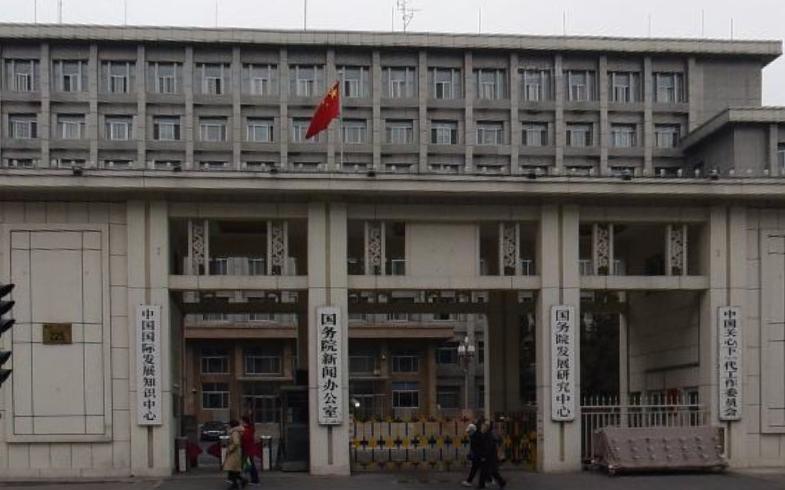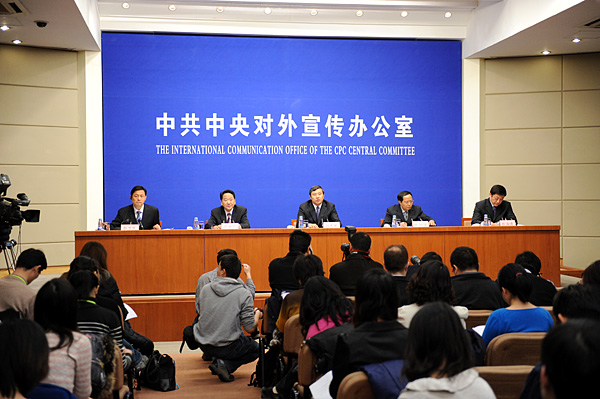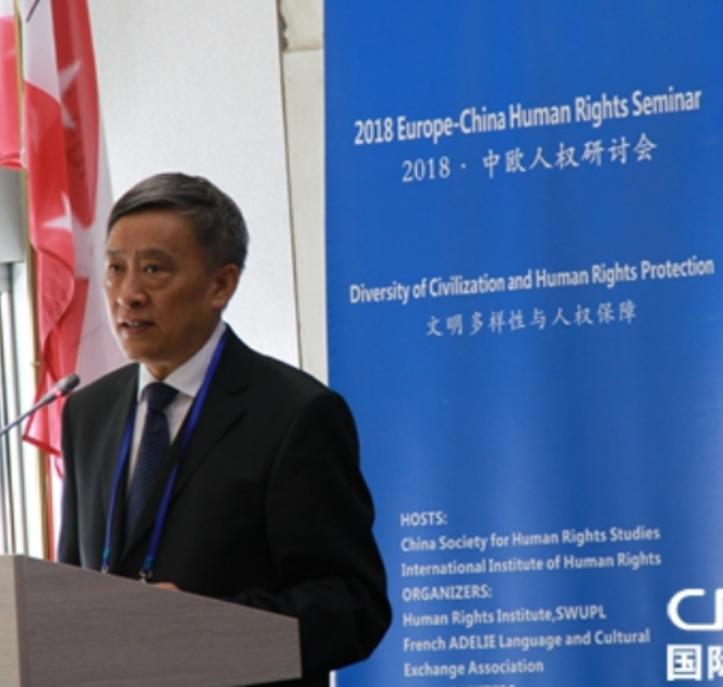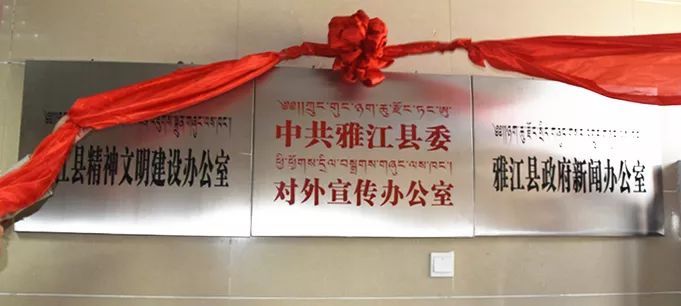The State Council Information Office (SCIO, 国务院新闻办公室) is the government nameplate used by the party agencies at the core of the CCP’s external propaganda bureaucracy. The precise identity of these agencies has changed over time: for most of its existence, SCIO was the state nameplate of the Office of External Propaganda (OEP, 中央对外宣传办公室) under the CCP Central Committee. Its current status, however, appears to have largely escaped foreign attention: in 2014, soon after the Xi era’s first conference on propaganda and thought work, OEP was absorbed by the Central Propaganda Department (CPD, 中央宣传部), thus making SCIO one of the CPD’s nameplates. The elimination of OEP, arguably Xi’s first major propaganda reform, coincided with the elevation of OEP’s Internet affairs component to a centrally-led cyberspace affairs system, as well as personnel changes that included an expulsion from the party and a (self-)defenestration. The reform, which brought much of the network of external propaganda agencies formerly overseen by OEP closer to the Propaganda Department, arguably anticipated the 2018 restructuring of media-control organs.1 A similar institutionalisation trend characterises Xi’s tenure elsewhere, notably in the united front system.
This note describes the 2014 reform and some of its consequences, updating existing descriptions of OEP and the CCP external propaganda bureaucracy.2

SCIO before Xi and the Office of External Propaganda
SCIO was set up in 1991 as the state nameplate of the central External Propaganda Small Group (EPSG, 中央对外宣传小组), which had been restored a year earlier as part of the post-Tian’anmen revitalisation of propaganda.3 The well-known double-nameplate arrangement was formalised in 1993: the party body behind the SCIO name became a self-standing organ under the Central Committee, the Office of External Propaganda (OEP, also translated as Office of Foreign Propaganda, 中央对外宣传办公室).4

OEP/SCIO, while led by CPD,5 came to oversee its own extensive component of the wider propaganda system. The office’s tasks included organising press conferences and other exchanges with foreign and domestic media, guiding the work of its local-level analogues, writing and publishing white papers, overseeing foreign-language publications, guiding online news and “building and managing Internet culture”.6 These tasks were assigned to a dedicated bureaucracy, with subordinate units that included, at a point, nine numbered functional bureaus, as well as supervised organs, notably the Foreign Languages Publishing Administration (中国外文出版发行事业局) and its controlled companies running print and online media outlets.7 Propagating the CCP’s narratives on Tibet and human rights was the task of the Seventh Bureau and an associated front, the China Society for Human Rights Studies (CSHRS, 中国人权研究会), established in 1993. CSHRS organises Tibet-themed propaganda tours abroad, runs its own human rights events and plays a central role in the CCP’s work to install its narrative on human rights at the UN.8 SCIO’s Internet-management component, by then consisting of its Fifth and Ninth Bureaus, was upgraded with the 2011 establishment of the State Internet Information Office (SIIO, 国家互联网信息办公室). At first just an OEP/SCIO nameplate,9 SIIO soon acquired full-time staff, while still preserving links to the Fifth Bureau.10
SCIO under Xi
Months after the Xi era’s first propaganda and thought work conference, amid a renewed stress on controlling public opinion and the challenges of the online domain,11 OEP’s Internet management component became the office of a new leading small group while the rest of OEP was merged into the CPD.
The Central Committee abolished OEP in March 2014.12 In February, SIIO, previously subordinate to SCIO, had been made the office of the new Central Cybersecurity and Informatisation Leading Small Group (中央网络安全和信息化领导小组), with the state nameplate now known in English as the Cyberspace Administration of China (CAC).13 The reform coincided with the loss of some SCIO Internet affairs personnel. Days after the Central Committee decision, Li Wufeng 李伍峰, a SCIO deputy director who had been Fifth Bureau director and later SIIO vice director, fell to his death from an office window.14 In April, the Central Commission for Discipline Inspection announced it was investigating a Fifth Bureau deputy director.15 CAC’s link to SCIO was further diluted in 2015 when CAC officials with Fifth Bureau backgrounds, including a deputy director, were moved to other posts.16 The Cybersecurity and Informatisation LSG was upgraded to a commission and acquired new competencies in 2018.17
The 2014 reform reduced SCIO to a CPD nameplate, primarily used for the activities of one of its bureaus, with its subordinate units now directly controlled by CPD and double-plated with SCIO names.18 Like all his predecessors except one, today’s SCIO director, Xu Lin 徐麟, is concurrently a CPD deputy head. In recent appearances, CPD officials using SCIO capacities often have current or past links to the CPD External News Bureau (对外新闻局), which appears to continue the former OEP First Bureau.19 SCIO deputy director Guo Weimin 郭卫民, currently a member of the CPD departmental affairs conference (部务会议), headed the OEP First Bureau until its abolition and immediately became head of the CPD External News Bureau.20 Guo’s successor and the bureau’s post-reform deputy directors are typically described as affiliated with the CPD or SCIO External News Bureau, or both.21 A SCIO webpage gives the names of External News Bureau personnel as CPD and SCIO spokespeople, again pointing to the interchangeability of the positions.22

CSHRS, previously run by the OEP/SCIO Seventh Bureau, now functions as a front of the CPD Human Rights Affairs Bureau, occasionally using an additional nameplate as an identically named SCIO bureau.23
The CPD has continued to use the SCIO name to run the spokesperson system after the reform, regularly evaluating departments based on the frequency of their press releases, their ability to deal with sudden events, reflect social concerns and shape public opinion.24 On the other hand, an OEP unit that participated in propaganda cadre training migrated to CAC in 2015, with its remit now restricted to the cyberspace affairs system.25

Years after the abolition of OEP at the central level, some subnational jurisdictions continued to maintain a unit of that name, in some cases as late as 2021.26 While one provincial OEP had been reduced to a nameplate of the local propaganda department by 2017,27 the case of Shanghai shows a surviving unit with its own structure and budget as of 2020.28 Some local OEPs have been dissolved since 2018, mirroring the earlier central-level reform.29 It remains unclear how many of the recent mentions of local OEPs refer to persistent standing bodies, as opposed to mere propaganda department nameplates. As related offices usually coalesce at smaller, lower-level bureaucracies, the impact of the reform would be less significant in party committees at the prefecture level and below.
Conclusion
The 2014 absorption of OEP into CPD can be seen as an early sign of the Xi-era’s centripetal restructuring of the propaganda system. Given the number of external propaganda agencies overseen by OEP/SCIO, the change was at least as significant as the better-known 2018 reform that collapsed former government organs into the CPD. The trend is analogous to that affecting the united front system, with the establishment of a leading small group in 2015 and the 2018 absorption of state diaspora and religious affairs offices by the United Front Work Department.30 The consolidation of a cyberspace affairs system, anchored in a CPD-led office but overseen by a commission chaired by Xi himself, likely reflects a need to coordinate a policy domain that involves security and other agencies beyond propaganda. While the personnel issues at OEP’s former cyberspace affairs units around the time of the reform might look like a purge, a reading as a sign of the new leadership’s dissatisfaction with OEP’s Internet management work must remain speculative.
The dissolution of OEP, a major reform of the CCP’s external propaganda bureaucracy, is six year-old news. Although, as common with party propaganda organs, the change was not publicly announced at the time, Chinese-language sources pointing to the change have been available for years. The lack of reflection of the change in much secondary literature further points to the need for original-language research to regularly update knowledge of key components of China’s political system.
Tobiáš Lipold’s contributed research and Martin Hála and Ondřej Klimeš’s comments on an early draft are gratefully acknowledged.
-
The 2018 restructuring similarly collapsed some of these organs into CPD (“中共中央印发《深化党和国家机构改革方案》”, 新华, 21st Mar. 2018; Matthew D. Johnson, “Safeguarding socialism: The origins, evolution and expansion of China’s total security paradigm”, Sinopsis, 11th June 2020, pp. 29 sq.).↩︎
-
Well-known works on the CCP propaganda system, including its external propaganda component, include David Shambaugh, “China’s Propaganda System: Institutions, Processes and Efficacy”, The China Journal 57 (2007), Anne-Marie Brady, Marketing Dictatorship: Propaganda and Thought Work in Contemporary China, Rowman & Littlefield, 2007, and later publications by those and other authors. The most complete study of CCP external propaganda, including a detailed treatment of the bureaucracy behind OEP until early 2013, is Mareike Ohlberg, “Creating a favorable international public opinion environment: External propaganda (duiwai xuanchuan) as a global concept with Chinese characteristics”, PhD thesis, University of Heidelberg, 6th Mar. 2013, whose account our first section largely follows. Although we have not found mentions of the elimination of OEP in secondary literature, it should of course be assumed that other authors have noticed some of the multiple mentions of the change in Chinese-language sources. We welcome references to earlier secondary publications noting the dissolution of OEP and would gladly update the article to reflect their existence.↩︎
-
The EPSG, established in 1980, was dissolved at the central level in 1988, months after a renewed focus on domestic propaganda crystallised in the establishment of the central Propaganda and Thought Work Leading Small Group (中央宣传思想工作领导小组) (Brady, op. cit., ch. 7; Ohlberg, op. cit., pp. 243 sqq., 276 sq., 298 sq., 303). The latter, currently chaired by Wang Huning 王沪宁, still forms the apex of the CCP propaganda system. For a recent treatment of the roles and structure of (leading) small groups and commissions, see Wen-Hsuan Tsai & Wang Zhou, “Integrated Fragmentation and the Role of Leading Small Groups in Chinese Politics”, The China Journal 82 (2019), with further references.↩︎
-
“中共中央机构沿革概要”, 中央机构编制委员会办公室, 18th Jan. 2019. As Ohlberg notes, the change likely amounted to a renaming of the existing office of the new EPSG, which, unlike its predecessor in the 1980s, was its own standing body rather than just a bureau within CPD. While the central EPSG seems to disappear from the public record after 1993, it might have continued to exist with OEP as its office (Ohlberg, op. cit., pp. 303 sq.). An external propaganda peak body resurfaced in 2004 with the establishment of the central External Propaganda Work Leading Small Group (EPWLSG, 中央对外宣船工作领导小组) (ibid., pp. 413, 486 sqq.). The central EPWLSG has had a limited public footprint, leaving us with little to add to Ohlberg’s 2013 discussion; in particular, the impact of Xi-era restructurings of the propaganda system on it remains unknown. Ohlberg’s mention of Ministry of Public Security representation at the group can now be confirmed with more official sources, documenting the central group’s existence as of 2009 (“应急管理部领导班子名单和简历 黄明任党组书记 王玉普任部长”, 中国经济网, 23rd Mar. 2018; “留党察看二年、行政撤职处分”, 新华, 31st July 2017; for the expected LSG membership of CPD deputy head-level cadre, see, e.g. “吉炳轩同志简历”, 东北网, 25th Apr. 2012). Recent sources do, on the other hand, confirm that EPWLSGs have remained active at the provincial and lower levels. An article on studying the spirit of Xi’s speech at the 2013 propaganda conference by a Nanning propaganda cadre, focused on province and city-level propaganda work, noted a need to improve the system of EPWLSG joint meetings (联席会) (冯力, “创新对外宣传工作应在四方面下功夫 ——学习领会习近平总书记8·19重要讲话精神”, 广西日报, via 中国共产党新闻网, 15th Oct. 2013). Xi-era evidence shows that at least some EPWLSGs have continued to function at the province and lower levels (Beijing: “北京市人民政府新闻发言人张劲林”, SCIO, 10th Mar. 2017; “北京不再受理入境人员居家隔离申请 尚在居家观察的入境人员确保足不出户”, 每日经济新闻, 19th Mar. 2020); Zhejiang: “浙江省委对外宣传工作领导小组会议召开 唱响浙江声音”, 浙江在线, 28th Mar. 2015; Shandong: “山东外宣移动客户端”感知山东”正式上线”, 中国山东网, 26th Apr. 2016; Hunan: 李慧 & 杨杨, “蔡振红把湖南故事讲得更加生动精彩”, 红网, 18th Jan. 2018; Harbin: “2016 年度中共哈尔滨市委宣传部部门预算”, 中共哈尔滨市委宣传部, 19th Feb. 2016; Hangzhou: 黄宇翔, “市委召开对外宣传工作领导小组会议”, 25th Aug. 2017; Yuyao, Zhejiang: “余姚市2011年度大事记”, 14th Dec. 2017; Dehong, Yunnan: “关于进一步加强和改进对外人文交流和对外宣传工作的实施意见”, 德宏州人民政府, 13th Mar. 2018; Drakgo བྲག་འགོ་, Kandze, Sichuan: “炉霍县人民检察院2019年对外宣传工作总结”, 炉霍县人民检察院, 15th Apr. 2019). Beijing provides a documented example identifying the local OEP with the office of the EPLWSG (“关于调整市农业普查领导小组成员的通知”, 北京市统计局 国家统计局北京调查总队, 19th Oct. 2016; 蒋子文, “北京日报社社长傅华任北京市委宣传部常务副部长”, 澎湃新闻, 13th Feb. 2017; “北京市人民政府新闻发言人张劲林”). The existence of local-level bodies does not, however, imply that of a central counterpart, as shown by the case of OEP itself.↩︎
-
OEP was headed by a CPD deputy head except for a few years around the turn of the century. See Ohlberg, op. cit., pp. 484 sq., 599.↩︎
-
“机构设置”; Ohlberg, op. cit., pp. 456 sqq.; “中国外文出版发行事业局”, 企查查. The Foreign Languages Publishing Administration runs, e.g., the multilingual China.org.cn / China.com.cn (中国网) websites (“关于我们”, 中国网; “局情概览”, 中国外文出版发行事业局).↩︎
-
Titus C. Chen, “A flamboyant mandarin in a declining liberal order: China’s revisionist agenda in global human rights institutions”, SSRN, 12th June 2019; Andréa Worden, “The Human Rights Council Advisory Committee: A new tool in China’s anti-human rights strategy”, Sinopsis, 6th Aug. 2019; Geoffrey Roberts, “One Chinese GONGO’s War against Global Human Rights”, China Change, 1st May 2020.↩︎
-
Ohlberg, op. cit., p. 461; “国办通知设立国家互联网信息办公室 王晨任主任”, 新华, 4th May 2011.↩︎
-
Qian Xiaoqian 钱小芊, the OEP deputy director initially double-hatted as SIIO’s deputy director (the other two SIIO deputy directors were vice ministers of public security and industry and information technology), led the OEP Fifth Bureau in the early 2000s (“钱小芊简历”, 中国作家网, 21st May 2018; “国务院新闻办公室”, 人民网, 20th Nov. 2001). Liu Zhengrong 刘正荣 had worked at the Fifth Bureau and led the Ninth immediately before moving to SIIO (by then known as CAC) in 2014 (“新华社副社长刘正荣已任中国记协党组书记”, 新京报, 12th Sept. 2020).↩︎
-
For discussion of the 2013 Conference on Propaganda and Thought Work, see Johnson, op. cit., pp. 24 sq.; David Bandurski, “Parsing the “public opinion struggle””, China Media Project, 24th Sept. 2013.↩︎
-
“中共中央机构沿革概要”, 中央机构编制委员会办公室, 18th Jan. 2019. Earlier evidence of the change includes a 2016 prospectus filed by a Xinhua Shanghai-listed subsidiary that referred to “the former [OEP]” (“首次公开发行A股股票招股说明书”, 新华网股份有限公司, via 金融界网, 17th Oct. 2016, p. 32) and the September 2017 update to the State Council organisation page on the Central People’s Government’s website, reflecting SCIO’s post-reform position (“国务院组机构”, 中国政府网, 9th Sept. 2017; cf. “国务院组机构”, 中国政府网, 9th Aug. 2017). Biographies of bureau and lower-level officials, cited below, provided further evidence.↩︎
-
“中央网络安全和信息化领导小组第一次会议召开”, 新华, 27th Feb. 2014; “習近平把中國建成網絡強國”, 文匯報, 28th Feb. 2014; Rogier Creemers, “The Pivot in Chinese Cybergovernance: Integrating Internet Control in Xi Jinping’s China”, China Perspectives 4 (2015); Christopher Cairns, “Fragmented Authoritarianism? Reforms to China’s Internetcensorship system under Xi Jinping”, 12th Sept. 2016.↩︎
-
“李伍峰”, SCIO, 19th Sept. 2012; 忻霖, “国新办副主任李伍峰坠亡”, RFA, 11th Apr. 2014; “国新办副主任李伍峰堕楼身亡”, 新浪香港, via 中国数字时代, 25th Mar. 2014. Li had appeared in public as late as a month earlier (“李伍峰副主任会见出席发布会的文化部蔡武部长”, SCIO, 24th Feb. 2014). Overseas media speculated on a link to a contemporary personnel change at China Three Gorges Corporation (忻霖, op. cit.), where Li had held an appointment between 2007 and 2008, but the leading officials removed from Three Gorges were soon moved to other senior posts, including a provincial governorship (“三峡集团换帅背后领导层不和几乎是”公开的秘密””, 财经国家新闻网, 14th Apr. 2014; “曹广晶简历”, 中国经济网, 29th Jan. 2018; “国务院三峡办副主任陈飞出任湖南省政府党组成员”, 中国经济网, 26th Dec. 2017). Li had reportedly been questioned by discipline officials (“Senior information official leaps six floors to his death, sources say”, South China Morning Post [27th Mar. 2014]). Another propaganda cadre committed suicide a month later, but a connection to Li’s death is not apparent (刘刚, 曾庆雪 & 罗婷, “新华社安徽分社副社长宋斌办公室身亡”, 新京报, 29th Apr. 2011).↩︎
-
“中央对外宣传办公室五局副局长高剑云涉嫌严重违纪违法问题被立案调查”, CCDI, 18th Apr. 2014. He was expelled from the party and removed from office in September (“中央网信办副局级干部高剑云被开除党籍和公职”, CCDI, 26th Sept. 2014).↩︎
-
Peng Bo 彭波 worked at the OEP Fifth and Ninth Bureaus before becoming SIIO/CAC deputy director in 2012 (岳怀让, “中央网信办、国家网信办人事再调整庄荣文任副主任”, 澎湃新闻, 20th Aug. 2015; “彭波 介绍”, 北京大学, 15th Oct. 2020). Liu Zhengrong (see fn. 10) also left CAC in 2015 (“新华社副社长刘正荣已任中国记协党组书记”). The loss of influence on Internet management of Hu era OEP cadre attracted the curiosity of some in China’s Neo-Maoist scene: officials like Peng, argued to have comparatively ‘liberal’ backgrounds, were, e.g., in charge of Internet-management units when leftist sites like Utopia (乌有之乡) were temporarily blocked during the fall of Bo Xilai (“国新办网站大变样是怎么了”, 乌有之乡, 19th Apr. 2014; 曹国星, “乌有之乡网站因”妄议十八大”被关闭整顿一个月”, RFI, 6th Apr. 2012; 老朱弟子, “宁可十年不将军不可一日不拱卒”, 博讯, 11th Apr. 2013; 恽仁祥, “致中共中央的公开信文章重发”, 上善若水网, 4th Mar. 2017; cf. 惲仁祥, 我親歷的國防科委文革, 中國文化傳播出版社, 2012; Julia Lovell, Maoism: A global history, Vintage, 2019, ch. 12).↩︎
-
“中共中央印发《深化党和国家机构改革方案》”, 新华网, 21st Mar. 2018.↩︎
-
“中央直属机构人物库”, 中国经济网. In addition to the transfers discussed below, one may note that OEP/SCIO’s last known secretary was identified as a CPD deputy secretary the year after the reform, while remaining active in external propaganda tasks and participating in a SCIO new year reception (“南开校友毕业30年返校1979年 那是一个春天”, 南开大学, 21st Oct. 2013; “我校成功举办第六届世界大学女校长论坛”, 中国传媒大学, 29th Sept. 2014; “才华秘书长与香港传媒高层在上海参观访问”, SCIO, 19th Dec. 2013; “首届中国—加勒比媒体研讨会在格林纳达举行”, 驻格林纳达大使馆, 24th Aug. 2015; “国新办2016年新年招待会”, SCIO, Dec. 2015).↩︎
-
The CPD External News Bureau, possibly created in 2014 to absorb the OEP First Bureau, remains distinct from the CPD News Bureau (“中宣部新闻局局长张小国视察国际台直播台”, CRI, 17th Oct. 2017; “汇聚优质内容创造融合精品”, 人民日报, 3rd Dec. 2019).↩︎
-
“中华人民共和国国务院新闻办公室”, SCIO; “机构设置”.↩︎
-
Both CPD and SCIO capacities have been used by current bureau director Hu Kaihong 胡凯红 (deputy until 2017) and deputies Xi Yanchun 袭艳春 (until 2020) and Wen Ge 温革. Another deputy is Xing Huina 邢慧娜. See “国新办新闻局副局长袭艳春调任山东省政府新闻办主任”, 新京报, 15th June 2020; ““我的2020″光影捕捉不平凡瞬间海外网直击”, 人民日报海外版, 1st Jan. 2021; 孔令瑶, “国务院新闻办公室对外新闻局副局长温革参加2019中国扶贫国际论坛”, 中国网, 18th Oct. 2019; “人民日报社举办2020国际十大新闻评选会”, 人民网, 18th Dec. 2020.↩︎
-
“中央国家机关和地方2020年新闻发言人名录”, SCIO, 16th Dec. 2019.↩︎
-
CSHRS’ secretary-general and legal representative since 2015, Lu Guangjin 鲁广锦, is a career propaganda cadre who had a deputy bureau-level position at OEP by the mid-2000s (“全国性社会团体成立登记公告”, 民政部, 7th Jan. 2015; “新闻办新闻局副局长鲁广锦主持发布会”, 中央政府门户网站, 2nd June 2008; “蔡名照会见汤森路透集团全球首席执行官吉姆·史密斯”, SCIO, 9th Oct. 2013). Official sources in recent years have identified Lu and a deputy with analogous positions at the CPD and SCIO Human Rights Affairs Bureaus (“徐南山总领事与”感知中国”演出团组座谈”, 驻亚历山大总领事馆, 19th July 2017; ““新时代中国人权事业的发展”展览在联合国日内瓦总部开幕”, 新华, 6th Nov. 2018; “鲁广锦 中宣部人权事务局局长、中国人权研究会秘书长、《人权》杂志社社长兼总编辑”, 中国人权网, 14th Jan. 2019; ““人权蓝皮书10周年暨中国人权理念、话语和理论” 网络研讨会议程”, 中国日报网, 20th Dec. 2020; “我院龚向和教授受邀参加”人权蓝皮书10周年暨中国人权理念、话语和理论”视频研讨会”, 东南大学, 21st Dec. 2020). CSHRS’ constitution as displayed on a page on its website updated in 2018 continues to refer to SCIO as its professional supervising unit (“中国人权研究会章程”, 中国人权网, 8th Jan. 2018). For Lu’s recent treatment of the history of human rights and the CCP’s contribution to that cause, see 鲁广锦, “历史视域中的人权中国的道路与贡献”, 红旗文稿 1 (2021), via 求是网.↩︎
-
吴姗 & 邵玉姿, “新闻发布你例行了吗”, 人民日报, 25th May 2017; “2018年度全国新闻发布工作评估情况公布”, SCIO, 22nd July 2018.↩︎
-
The OEP/SCIO Cadre Training Centre (Ohlberg, op. cit., p. 462; “山东省临沂市首期党委政府新闻发言人培训班在京举行”, SCIO, 8th July 2011; “扫描新闻发言人培训班”, 中国网, 26th Oct. 2004) became the CAC Cadre Training Centre (“国家事业单位登记管理局公告”, 国家事业单位登记管理局, 6th Aug. 2015). For some of its recent activities, see “网络安全企业’走出去’座谈会”, 中国网络空间安全协会, 2016; “2019年全国网信系统信息员培训班在京举办”, CAC, 10th Dec. 2019.↩︎
-
Beijing (“北京市侨办与市外宣办座谈 加强信息沟通和协调”, 中国侨网, 7th May 2015; “我看北京这五年外国媒体人讲述北京发展故事”, 北京青年报, via 新华网, 23rd Oct. 2017; 张祥, “庞星火回应新冠疫苗能保护多久”, 环球网, 7th Jan. 2021); Shanghai (“主要职责”, 上海市人民政府新闻办公室); Heilongjiang (金缕春 & 颜世龙, “毛振华控诉黑龙江亚布力管委会 潘石屹声援喊冤是为社会进步”, 中国经营网, 2nd Jan. 2018; “期刊基本信息表”, 黑龙江宣传政务公开, 23rd Apr. 2020); Inner Mongolia (“邢海明大使会见内蒙古自治区区委宣传部副部长、外宣办主任韩昀祥一行”, 驻蒙古国大使馆, 3rd May 2018; “内蒙古新华控股有限公司引入战略投资者签约仪式在内蒙古产权交易中心举行”, 人民网, 19th Sept. 2020); Ningxia (“宁夏举行扫黑除恶专项斗争重点行业领域乱象整治新闻发布会”, SCIO, 3rd Dec. 2020); Shaanxi (赵波 & 王泽昊, “陕西省精神文明建设呈现蓬勃发展的良好局面”, 今日陕西, 27th July 2018); Hebei (External Propaganda Bureau) (“中央和国家机关有关部委各省、自治区、直辖市党委和政府新闻发言人名单及新闻发布工作机构电话”, 人民网, 19th Dec. 2017; “河北省新闻发言人李丽”, SCIO, 16th Jan. 2018); Henan (“省委外宣办、省文旅厅一行到我市调研”, 灵宝市人民政府, 28th Oct. 2020); Shandong (“山东省委外宣办主任魏长民”, SCIO, 5th Nov. 2016); Sichuan (蒋子文, “四川省委外宣办副主任代光举履新四川省干部函授学院党委书记”, 澎湃新闻, 6th Mar. 2020); Anhui (“关于王颖等同志任职的通知”, 安徽文明网, 3rd July 2018; “郑明武主持召开疫情防控外宣工作专题会议”, 安徽文明网, 5th Mar. 2020); Jiangsu (““帅”字当头折扇轻摇赴”战场””棋”思妙想中国寻梦摘”探花””, 扬州大学, 20th June 2017; “我县荣获省对外宣传工作创新奖”, 射阳文明网, 19th Jan. 2018); Guizhou: (“中央和国家机关有关部委各省、自治区、直辖市党委和政府新闻发言人名单及新闻发布工作机构电话”); below the province level, e.g., Ningbo, Zhejiang (张海玉, “名城名都、文明城市…2017宁波十大流行热词出炉”, 现代金报, via 浙江在线, 1st Jan. 2018); Ya’an, Sichuan (“雅安市人民政府办公室关于调整市森林防灭火指挥部组成人员及办公室设置的通知”, 雅安市人民政府办公室, 31st Dec. 2020).↩︎
-
“2016年度中共吉林省委宣传部部门决算”, 吉林省文明网, 25th Aug. 2017. For a prefecture-level example, see Zhaotong, Yunnan: 红色扎西, “附部门职责昭通多家新部门正式挂牌来看看他们的新名字…”, 搜狐, 10th Mar. 2019. (On the ‘Red Zhaxi’ social-media channel (the name alludes to the Red Army’s stop there during the Long March), run by the Zhaotong Organisation Department, cf. idem, “厉害了”红色扎西”微信公众平台首篇100000+的原创文章居然是…”, 21st May 2018; “云南昭通打造”红色扎西”品牌 提高党建”最强音””, 云南干部教育网, 24th Mar. 2017.)↩︎
-
“上海市2020年市级单位预算 预算单位中共上海市委对外宣传办公”, 上海市人民政府.↩︎
-
陈俊琦, “山西省级党政机构设置60个”, 山西日报, via 人民网, 29th Oct. 2018.↩︎
-
Alex Joske, “Reorganizing the United Front Work Department: New Structures for a New Era of Diaspora and Religious Affairs Work”, China Brief 19.9 (9th May 2019); idem, “The Central United Front Work Leading Small Group: Institutionalising united front work”, Sinopsis, 23rd July 2019.↩︎
